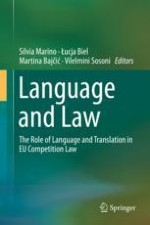2018 | OriginalPaper | Chapter
Collocations of Terms in EU Competition Law: A Corpus Analysis of EU English Collocations
Authors : Łucja Biel, Agnieszka Biernacka, Anna Jopek-Bosiacka
Published in: Language and Law
Publisher: Springer International Publishing
Activate our intelligent search to find suitable subject content or patents.
Select sections of text to find matching patents with Artificial Intelligence. powered by
Select sections of text to find additional relevant content using AI-assisted search. powered by
